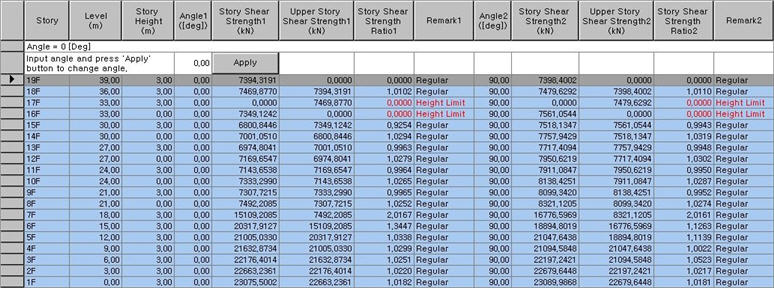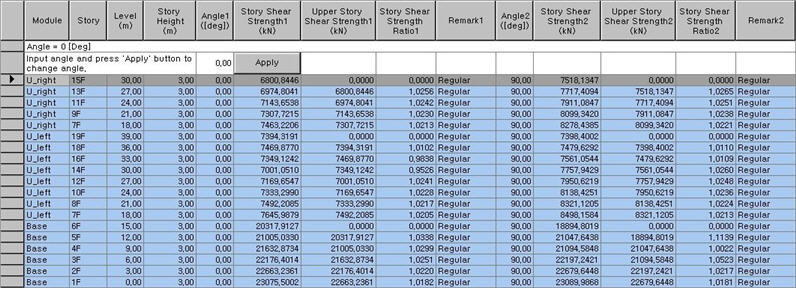Capacity Irregularity Check (Weak Story) Table
Generate the story strength and the results of evaluation of weak story to check capacity irregularity in a spreadsheet format table.
Story strength is the total strength of seismic-resisting elements sharing the story shear for the direction under consideration. The story strength and the results of evaluation of weak story exhibiting discontinued strength are tabulated.
When "Story Shear Force Ratio>Consider Story Module" is checked in the "Model/Building/Control Data", accurate shear forces can be obtained for the story having the overlapping Module.
When Modules are defined in Results > Result Tables > Story > Define Module, the Module data is displayed in the first column of the table.
When the ratios exceed the allowable limit, they appear in red and 'Irregular' is printed in the Remark.
Table Tool in midas Gen offers a variety of powerful built-in functions. Refer to the following items for detail directions:
Usage of Table Tool
Terminology
Familiarize with Usage
Basic directions (Cell motion, selection, size control, etc.)
Data manipulation (Add, delete, modify data, etc.)
Copy/Paste data using clipboard
Supplementary Table functions
Table Sorting
Table format setting
Auto-fit column width
Graph printing
Supplementary functions by Table types
Node/Element Table
Results Table
From the Main Menu select Results > Result Tables > Story > Capacity Irregularity Check (Weak Story).
Select Result Tables > Story > Capacity Irregularity Check (Weak Story) in the Tables tab of the Tree Menu.
Refer to Usage of Table Tool and check the following data:
![]() When Modules are not defined
When Modules are not defined

Story: Story number
Level: Elevation of the Story
Story Height: Story (floor to floor) Height
Angle: Specify a load direction
1. Story Shear Strength Coefficient
The story strength is calculated in the load direction specified by the user, as well as perpendicular to the load direction. Once Angle1 is entered in "Input angle and press 'Apply' button to change angle", Angle2 automatically becomes Angle1 + 90˚
The following equation is used to calculate Story Shear Strength for vertical elements at a corresponding story.
Story Shear Strength = ![]()
(ACI is used for the above equation, except for the cases where Japanese and Chinese design codes are selected.)
2. Upper Story Shear Strength Coefficient
Story Shear Strength of vertical members immediately above the story in question
3. Story Shear Strength Ratio
Story Shear Strength at a story divided by the Story Shear Strength immediately above the story in question
4. Remarks
If the Story Shear Strength Ratio exceeds 0.8, "Regularity" is printed. If the Ratio is between 0.65 and 0.8, "Irregularity" is printed. If it is below 0.65, "Height Limit" is printed.
In the case of Roof, there is no story above the roof. In that case, always "Regularity" is printed.
![]() When Modules are defined
When Modules are defined
The Module column is generated only when the Modules are defined. Results of evaluation of capacity irregularity are calculated as per the following Note.
Note
Upper Story Shear Strength and Story Shear Strength Ratio for the story immediately below the top floor of each Module, is displayed as 0 and marked as Regular.
Module: Module name is defined in Define Module
Story: Story number
Level: Elevation of the Story
Story Height: Story (floor to floor) Height
Angle: Specify a load direction
1. Story Shear Strength Coefficient
The story strength is calculated in the load direction specified by the user, as well as perpendicular to the load direction. Once Angle1 is entered in "Input angle and press 'Apply' button to change angle", Angle2 automatically becomes Angle1 + 90˚
The following equation is used to calculate Story Shear Strength for vertical elements at a corresponding story.
Story Shear Strength = ![]()
(ACI is used for the above equation, except for the cases where Japanese and Chinese design codes are selected.)
2. Upper Story Shear Strength Coefficient

Story Shear Strength of vertical members immediately above the story in question
3. Story Shear Strength Ratio
Story Shear Strength at a story divided by the Story Shear Strength immediately above the story in question
4. Remarks
If the Story Shear Strength Ratio exceeds 0.8, "Regularity" is printed. If the Ratio is between 0.65 and 0.8, "Irregularity" is printed. If it is below 0.65, "Height Limit" is printed.
In the case of Roof, there is no story above the roof. In that case, always "Regularity" is printed.